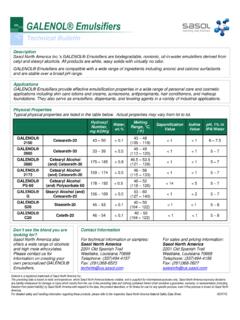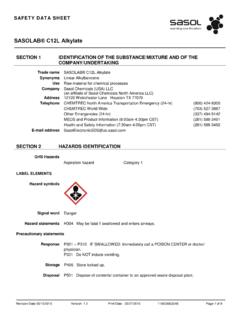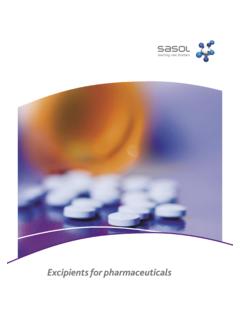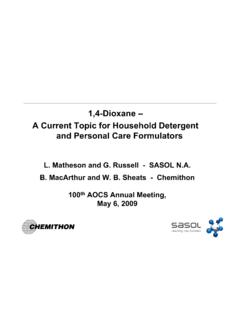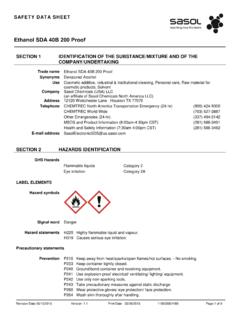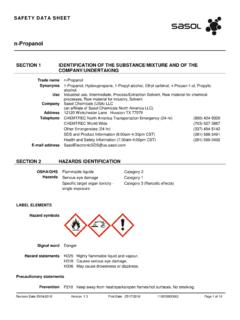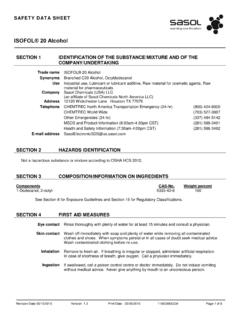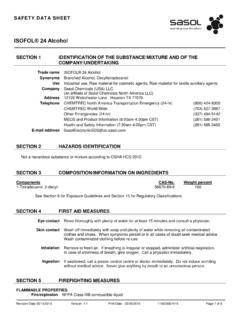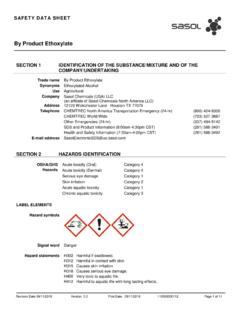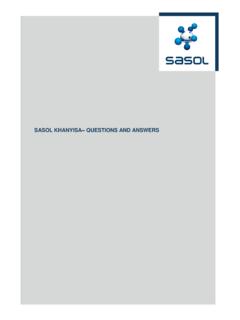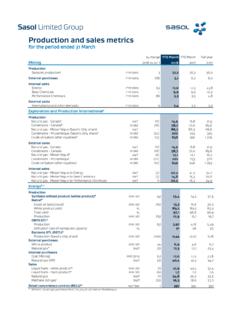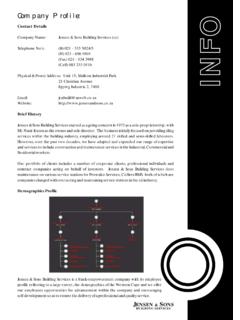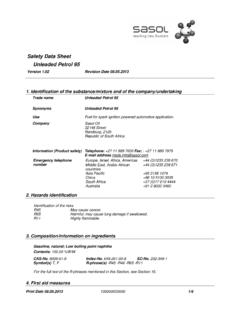Transcription of Sasol Germany GmbHSasol Germany GmbH - …
1 DISPERAL /DISPAL High purity dispersible aluminasSasol Germany GmbHSasol Germany GmbHFeatures of Sasol dispersible aluminasThe unique product characteristics of Sasol dispersible aluminas can lead to many advantages for use in different systems. Some key features are: The aluminas are synthetic. Being synthetic, these high purity mate-rials are produced under careful control to yield products with consistent quality and reliable performance. Both powders and pre-dispersed alumina are available. Thus, you can choose the form that is most appropriate for your processing needs. The powders are highly dispersible.
2 Low viscosity nano-particle sols can be prepared at room temperature in 10 to 30 minutes. The aluminas are versatile. They can be employed under a variety of application conditions, including low or high pH and low or high shear. Sasol also offers aluminas which are dispersible in organic media, eg alcohols, dimethylformamide (DMF) and DISPAL are the trade-names for the high purity, highly dispersible, boehmite alumina powders and sols/dispersions manufactured by Sasol in Brunsb ttel, Germany and in Lake Charles, Louisiana, USA. These aluminas, which are nano-sized in the dispersed phase, exhibit a unique com-bination of purity, consistency and dispersibility that make them excellent materials for use in colloidal applications.
3 The Sasol range of dispersible boehmites has traditionally been used in applications such as sol-gel ceramics, catalysis, refractory materials, rheology control and surface more recently developed uses include surface coating as well as paint of DISPERAL and DISPAL aluminasSasol pioneered processes utilizing alkoxide chemistry to convert primary aluminum metal into synthetic boehmite aluminas of exceptional purity. Unlike other alumina manufacturing processes that start with less pure materials, Sasol s processes yield aluminas with significantly lower levels of common impurities such as iron, sodium and silica (table 1).
4 Additionally, our 30 years of experience, in combination with other proprietary production techniques, allows us to produce highly dispersible aluminas with a wide range of physical properties such as dispersed particle size (figure 2) resulting in translucent to opaque dispersions (figure 1). Thus, you do not need to be limited in your thinking and development of novel alumina-containing /DISPAL High purity dispersible aluminas2 |Chemical purity of DISPERAL and DISPAL alumina powdersImpurity ppm (typical)Na2O 20Fe2O3 100 SiO2 120 Table 1 | 3 Dispersed part ic le size distributions of sele cted productsDiameter (nm)
5 35201510052530% in class10100100050050 Figure 2 Dispersed particle size distributions of selected productsFigure 1 Translucent to opaque alumina sols, each with a concentration of 10 Al2O3 How to disperse and use DISPERAL and DISPAL aluminasDISPERAL and DISPAL powders may be dispersed by following the descriptions below. Figure 3 shows a schematic representation of what occurs to the powder during dispersion using chemical attack and mechanical energy. Water dispersible aluminaTo form a colloidal sol or dispersion from a water dispersible DISPERAL or DISPAL alumina powder, simply stir the powder in deionized water with moderate to intense agitation at room temperature for 20 30 minutes.
6 The maximum achievable solids loading will vary according to the specific alumina product selected (figure 4). For most applications, the aluminas perform best when completely dispersed prior to further dispersible aluminaDispersions of acid dispersible products may be formed in a similar fashion described above by dispersing in dilute aqueous monovalent acids such as nitric, hydrochloric, formic or acetic (typically < 1 acid).4 |Detailed descriptions of the dispersing procedure are available on scosity versus pHVi scosity (mPa s)pH110,0001410100101112139876543210 Flocculation1000 Figure 5 Viscosity versus pHVi scosity versus alumina concentrationAl2O3 ( w t.)
7 %)10,000504030201010010Vi scosity (mPa s)1000 Figure 4 Viscosity versus alumina concentration for different productsSchematic mechanism of dispersionPrimary aggregates20-500 nmAgglomerates5-10 micronPowder par ticle40 micronMechanicalenergyChemicalattackMech anicalenergyFigure 3 Schematic mechanism of dispersionOrganic dispersible aluminaSasol dispersible aluminas may be dispersed in organic solvents, for example, a dispersion in DMF may be prepared by dispersing the alumina powder, under intense mixing, into DMF containing nitric acid. Information on dispersions in more sophisticated organic systems are available, please contact one of our characteristics of alumina dispersions can be affected by numerous factors.
8 These include product used, solid content, crystallinity, water quality, pH and other formulation components. Figure 4 gives example curves of viscosity versus alumina concentration for some typical Sasol products. Also low viscosity dispersions can be thickened by the addition of acids, bases or salts to form thixotropic, shear-thinning systems (figures 5 and 6). This, for example, allows alumina to function as a thickener for many types of either acidic or basic formulations. | 5 Effect of alumina concentration on viscosity versus shear rat eVi scosity (mPa s)40003500300025002000150010005000 Shear rate (1/s)Aluminaconcentration(wt.)
9 %)20 %15%10%5 %0. 1100110 Figure 6 Effect of alumina concentration on viscosity versus shear rateFigure 7 Transmission electron micrograph of a dispersible alumina (magnification: 180,000x)Analytical methodsCrystallite size Crystallite plane dimensions in powdered alumina samples are analyzed using X-ray diffraction techniques on X-ray diffracto-meters supplied by Siemens or particle size The particle size distribution of diluted alumina sols and dispersions is measured using laser diffraction or photon correlation spectroscopy techniques on Malvern or Cilas of alumina powder A specified amount of alumina powder is added to water or dilute acid under stirring.
10 The mixture is then stirred for a specified period of time to form a dispersion. The dispersion is centrifuged, and the undispersed residue is isolated, dried, and weighed to determine the percent non-dispersed material. Surface area The boehmite aluminas are first calcined at 550 C for three hours in preparation for analysis. Alumina surface area is then measured using BET nitrogen adsorption tech-niques on instruments supplied by Quantachrome (Nova series) or by Micromeritics (Gemini series).Trace element analysis Trace element analysis is performed by using several methods, including X-ray fluorescence of pressed alumina disks and wet techniques (ICP/OES).
